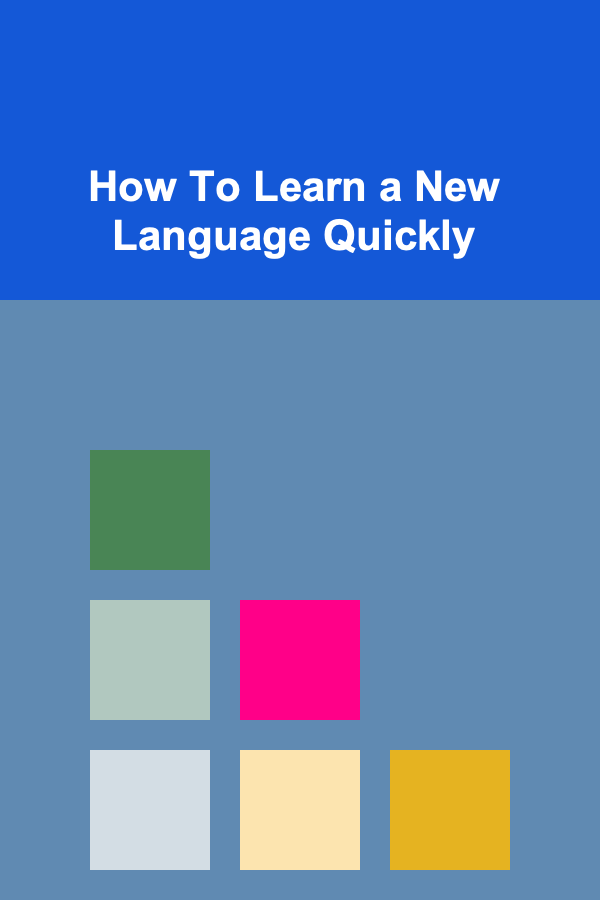
How To Learn a New Language Quickly
ebook include PDF & Audio bundle (Micro Guide)
$12.99$5.99
Limited Time Offer! Order within the next:

Learning a new language can be a challenging yet immensely rewarding endeavor. Whether you want to communicate more effectively while traveling, expand your professional opportunities, or simply learn for personal growth, becoming fluent in a new language can open up a whole new world of possibilities. The question, however, is: How can you learn a new language quickly and efficiently?
In this article, we'll explore various strategies, tips, and approaches that can help you learn a new language at a faster pace. While language learning is inherently a gradual process, with the right tools and mindset, you can make significant progress in a relatively short amount of time.
Set Clear Goals
Before diving into the vast ocean of vocabulary and grammar rules, it's important to establish clear, measurable, and realistic goals for yourself. Simply saying "I want to learn Spanish" is too vague. Instead, break it down into more specific objectives, such as:
- Short-term goals: Learning basic phrases for ordering food, asking for directions, and introducing yourself.
- Medium-term goals: Being able to hold a basic conversation or understand a news report in the target language.
- Long-term goals: Achieving fluency and being able to participate in complex conversations without hesitation.
Setting clear goals helps you track your progress and stay motivated. Moreover, it provides you with direction, so you know exactly where to focus your energy.
1.1 Start With the Most Common Vocabulary
One of the best ways to accelerate your learning process is to start with the most commonly used words in the language. In any language, 100 or 200 words will cover about 50-60% of all spoken interactions. Learning these high-frequency words will immediately give you the ability to understand and form basic sentences.
You can often find lists of high-frequency words or "core vocabulary" for many languages online. Focus on mastering these words before diving into less commonly used vocabulary. Apps like Anki or Memrise can help you study these words efficiently.
Immersion Is Key
One of the fastest ways to learn a new language is to immerse yourself in it. Language immersion involves surrounding yourself with the language as much as possible, so it becomes a natural part of your environment. While full immersion might seem daunting, there are several ways to simulate it, even if you're not living in a country where your target language is spoken.
2.1 Surround Yourself With the Language
This means listening to music, watching movies, TV shows, or YouTube videos in your target language. The goal is to expose yourself to the language regularly so that you start to pick up on patterns and nuances. Try to watch content that aligns with your language level. If you're a beginner, consider starting with children's shows or cartoons, as they often use simpler language.
2.2 Change Your Device Settings
Changing your phone, computer, and social media settings to your target language can help reinforce vocabulary. By interacting with your devices in your new language, you'll familiarize yourself with the vocabulary used in everyday contexts. Every time you check your phone or computer, you'll be subconsciously reinforcing new words.
2.3 Practice with Native Speakers
The best way to truly immerse yourself in the language is to practice speaking it. While this can be intimidating at first, interacting with native speakers is crucial for improving pronunciation, gaining real-time feedback, and learning colloquial expressions. There are several ways to practice with native speakers:
- Language exchange apps: Apps like Tandem, HelloTalk, and Speaky connect you with native speakers for language exchange. You teach them your native language, and they teach you theirs.
- Language meetups: Many cities have language exchange meetups, where learners of different languages gather to practice speaking.
- Online tutoring: Services like iTalki and Preply allow you to connect with professional language tutors who can guide your learning through structured lessons.
2.4 Practice, Practice, Practice
Consistency is key when it comes to learning a new language. It's better to practice for 30 minutes a day than to cram for several hours once a week. Over time, this consistent practice will lead to gradual improvements.
Use Technology to Your Advantage
In today's digital age, there's a wealth of language-learning tools and resources available at your fingertips. These can help you learn faster and more efficiently. Here are a few tools and apps that can boost your language-learning efforts:
3.1 Language Learning Apps
- Duolingo: Duolingo is a popular app that uses gamification to help you learn vocabulary, grammar, and sentence structure. It's ideal for beginners and intermediate learners.
- Memrise: Memrise focuses on vocabulary acquisition and uses spaced repetition to help reinforce new words. It's great for expanding your vocabulary quickly.
- Babbel: Babbel is another app that focuses on conversation-based learning and can be particularly helpful if your goal is to speak the language in real-life scenarios.
- Anki: Anki is a flashcard app that employs spaced repetition to help you remember vocabulary and grammar rules. It's especially useful for memorizing new words and phrases.
3.2 Grammar Apps
For many learners, grammar can be the most challenging aspect of language acquisition. Luckily, there are several apps that can make this process more manageable:
- Lingvist: Lingvist adapts to your level and teaches you new vocabulary and grammar structures based on your previous answers.
- HelloTalk: In addition to being a language exchange app, HelloTalk allows you to send text messages, voice notes, and even make video calls with native speakers.
3.3 Podcasts and Audiobooks
Listening to podcasts and audiobooks in your target language can significantly improve your listening comprehension. Start with podcasts for language learners, which often feature slow and clear speech, then move on to more complex content as your skills improve.
- Coffee Break Languages: Offers podcasts for a variety of languages, tailored for beginners and intermediate learners.
- LingQ: Offers audiobooks, podcasts, and reading materials, all with transcripts to help you follow along.
Develop a Routine
A key aspect of learning a new language quickly is developing a routine that includes diverse types of practice. Learning a language isn't just about memorizing vocabulary or grammar rules; it's about applying those rules in real conversations. Your routine should include a mix of the following activities:
4.1 Daily Practice
It's crucial to dedicate at least 30 minutes to an hour each day to language learning. Whether it's reviewing flashcards, listening to a podcast, or having a conversation with a native speaker, make language learning a part of your daily life.
4.2 Use the 80/20 Rule
The 80/20 rule, also known as the Pareto Principle, states that 80% of results come from 20% of the effort. In language learning, this means focusing on the most useful aspects of the language. Mastering common words, phrases, and grammatical structures will give you the ability to communicate in most situations, even if you haven't mastered every aspect of the language.
4.3 Focus on Speaking
While reading and writing are important aspects of language learning, speaking is the most essential skill for quick learning. Don't worry about making mistakes; the key is to practice as much as possible. Even if you only know a few words, try to use them in context, and don't be afraid to communicate with native speakers. The more you speak, the more comfortable and confident you'll become.
4.4 Study Grammar in Context
Rather than memorizing abstract grammar rules, try to learn them in context. Instead of studying isolated rules, try to encounter them in real sentences or phrases. This will help you understand how the grammar is actually used in everyday speech, making it easier to apply.
Stay Motivated
Language learning is a long journey, and staying motivated can be challenging. However, maintaining motivation is essential for learning a new language quickly.
5.1 Celebrate Small Wins
Every milestone, no matter how small, is a step forward. Celebrate each victory, whether it's understanding a conversation or learning your 50th word. Acknowledging your progress will keep you motivated and make the process feel less overwhelming.
5.2 Find a Language Learning Community
Joining a community of language learners can help you stay motivated and provide a sense of accountability. Whether it's an online forum, a social media group, or a local meetup, interacting with other learners can provide encouragement, support, and valuable tips.
5.3 Use Gamification
Many apps and tools use gamification to make language learning more fun and engaging. Duolingo, for instance, uses levels, points, and streaks to keep you engaged and motivated to continue learning.
5.4 Be Patient and Persistent
Language learning is a marathon, not a sprint. There will be times when you feel frustrated or stuck, but it's essential to stay patient and persistent. With consistent practice, the language will start to feel more natural.
Conclusion
Learning a new language quickly is entirely possible with the right strategies and mindset. By setting clear goals, immersing yourself in the language, using technology to your advantage, and developing a routine, you can make significant progress in a short amount of time. Don't be afraid to make mistakes, stay motivated, and most importantly, enjoy the process. With dedication and perseverance, you'll soon find yourself speaking a new language with confidence and ease.

How to Build a Portfolio of Home Rental Properties for Long-Term Success
Read More
How to Create a Tax-Efficient Financial Plan
Read More
How to Create an Inventory System for Your Luxury Items
Read More
How to Showcase Outdoor Spaces When Staging My House
Read More
How to Use AR for Interior Design
Read More
How to Flip Products for Profit
Read MoreOther Products

How to Build a Portfolio of Home Rental Properties for Long-Term Success
Read More
How to Create a Tax-Efficient Financial Plan
Read More
How to Create an Inventory System for Your Luxury Items
Read More
How to Showcase Outdoor Spaces When Staging My House
Read More
How to Use AR for Interior Design
Read More